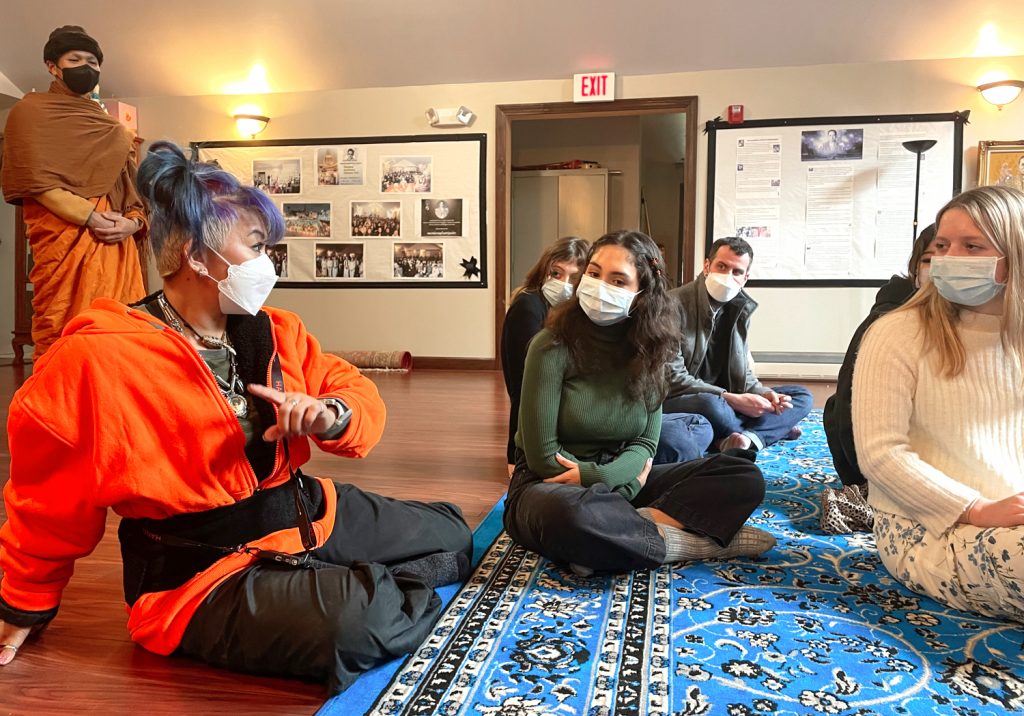About half an hour north of Boston, close to the New Hampshire border, lies an area of Massachusetts known as the Merrimack Valley. It’s a mix of rural areas and small cities, but what’s often overlooked is the region’s diverse, vibrant Buddhist community.
The Buddhist community has flourished here for decades, particularly after the arrival of thousands of refugees following the wars in Southeast Asia. Now, there are nearly a dozen Buddhist temples representing a variety of traditions and ethnicities—including Vietnamese, Thai, Laotian, Cambodian, Khmer, Chinese, and Japanese.
This spring, an innovative new course called “Listening to the Buddhists in Our Backyard” at Phillips Academy—a private boarding school in Andover, one of the towns in the Merrimack Valley—immersed high school seniors in these local Buddhist communities just miles from their own campus. Co-taught by author Chenxing Han and philosophy and religion instructor Andrew Housiaux, the class shows how embedded Buddhism is in the US, even in places where one might not expect.
“It invites anybody in the US to consider, ‘There’s Buddhism in my backyard,’” Han said.
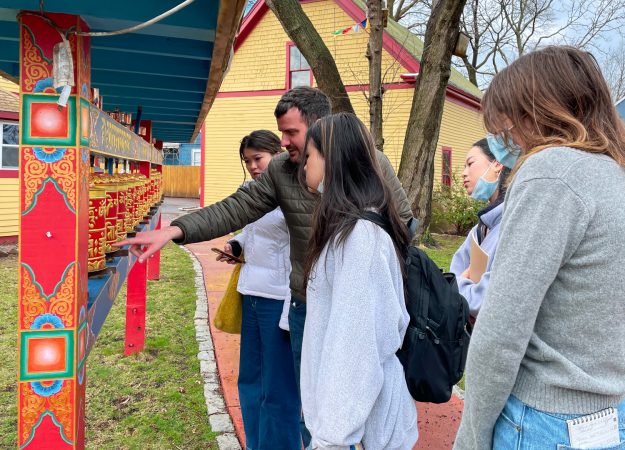
The idea for the 10-week course came about last year when Housiaux read Han’s book, Be the Refuge: Raising the Voices of Asian American Buddhists, in which she profiled dozens of young Asian American Buddhists. At the time, he was teaching a class on Asian religions, so he invited Han to be a guest lecturer and was struck by her approach.
“Rather than saying ‘Buddhism is about the Four Noble Truths,’ or, ‘Let’s start with Prince Siddhartha 2,600 years ago,’ she was saying, ‘Let’s listen to human beings,’” he said.
“Listening to the Buddhists in our Backyard” grew out of this concept, and Housiaux invited Han to co-teach the course with him. Another key instructor was the Buddhist community itself, as Housiaux, Han, and their six students visited nearly a dozen temples in the Merrimack Valley, plus a few others in Boston and Cambridge. The idea was to teach the high schoolers about the diversity of Buddhism in the US, but outside the classroom. So instead of starting with books about Buddhism and its history, they visited temples, observed and participated in rituals, attended youth groups, and spoke to monastics and laypeople.
“From the beginning, the students understood that American Buddhism is diverse and culturally-rooted, flipping the mainstream, white, convert-dominated narratives on their heads,” Han said. “What they modeled is a very different way of approaching American Buddhism.”
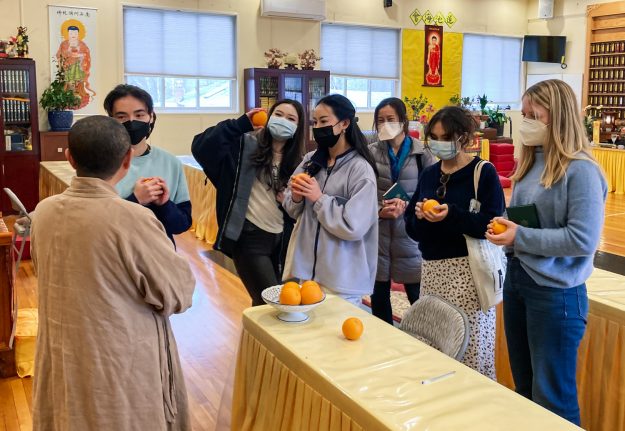
Calling it an “inversion of the typical pedagogy,” Housiaux said the class allowed students to experience the religion without a constructed view of what Buddhism is or who Buddhists are. “Otherwise they’d take that idea and go to certain temples and say, ‘Oh, why aren’t certain people meditating?,’ or ‘Why is this so ritualistic?’” he said. This approach also meant that students quickly picked up on the internal diversity of Buddhism firsthand, rather than simply reading about regional or philosophical differences, he added.
Melissa Damasceno, a 17-year-old senior from Houston, agreed. “I was able to get a much larger picture of what Buddhism is, instead of just reading a textbook. Buddhist concepts were actively demonstrated to us in the temples,” she said. “A lot of the class for me has been seeing a full picture of Buddhism, seeing all its colors and how it changes across different ethnic and immigrant communities.”
Han said the pedagogy also helped students absorb Buddhist principles in a deeper way. “If I read an article about being generous, it wouldn’t have stuck with me,” one student told Han. “But being the recipient of generosity, and practicing it ourselves, bringing oranges to the temples, giving donations, asking how I can help and helping them at Thai New Year—we’re going to remember this for a long time,” the student shared.
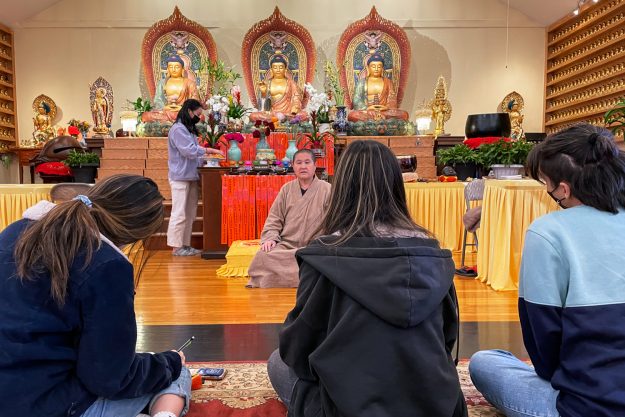
While all the temples were welcoming, Han said, it wasn’t always easy to gain access to these spaces because many of the practitioners don’t speak English, and communication required a significant amount of translation for Han and members.
The culmination of the course was an online conference in which the students presented what they learned about the communities—and pedagogy—to Buddhist educators, scholars, and community leaders across the US. They also met with researchers at Harvard Divinity School and wrote profiles of two of the temples they visited, American Wisdom Association and Chùa Tường Vân Lowell, for Harvard’s Pluralism Project, which researches religious diversity in the US.
“This is what the landscape of the US looks like today, and students like those at Phillips Academy continue to contribute to a more refined understanding of our own region,” Diana Eck, professor of comparative religion at Harvard Divinity School and founder and director of the Pluralism Project said in an email.
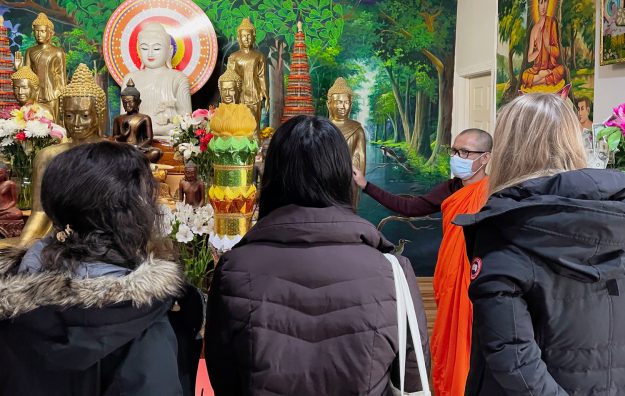
Some of the students’ learning went beyond academics. Damasceno said she’s also been applying Buddhist concepts to her own life, particularly the idea of impermanence. “I’ve been thinking about impermanence a lot as we transition out of high school and into a new phase of our lives,” she said. “What does it mean to end something and move on, in this course and in other aspects of life? It’s been refreshing to have the opportunity to think about what impermanence looks like and how we’re always in this transitory state.”
For Lesley Tan, a 17-year-old senior, the course has also made her think in new ways about her hometown in Southern California, where several Asian Buddhist temples have been vandalized amid the recent surge of anti-Asian hate crimes. “I was thinking about how Buddhism is so present in my community back home, and how I never really recognized that until this term,” she said. “I want to go back and explore the Buddhist temples nearby.”
Han noted this is perhaps the biggest lesson of the course, which will return next spring.
“You can find Buddhism anywhere,” she said.
♦
Thank you for subscribing to Tricycle! As a nonprofit, we depend on readers like you to keep Buddhist teachings and practices widely available.
